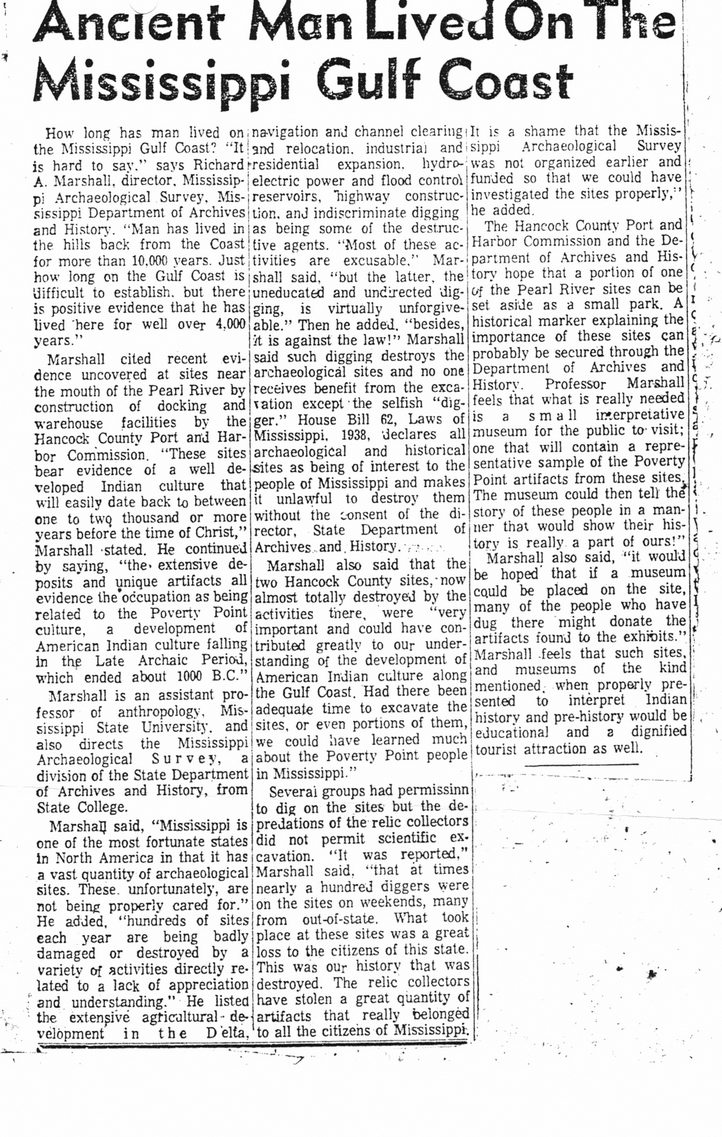This text was obtained via automated optical character recognition.
It has not been edited and may therefore contain several errors.
Ancient Men Lived On The Mississippi Gulf Coast How long has man lived on the Mississippi Gulf Coast? “It is hard to say.” says Richard A. Marshall, director. Mississippi Archaeological Survey. Mississippi Department of Archives and History. “Man has lived in the hills back from the Coast for more than 10.000 years. Just how long on the Gulf Coast is difficult to establish, but there is positive evidence that he has lived here for well over 4,000 years.” Marshall cited recent evidence uncovered at sites near the mouth of the Pearl River by construction of docking and warehouse facilities by the Hancock County Port and Harbor Commission. “These sites bear evidence of a well developed Indian culture that will easily date back to between one to twq thousand or more years before the time of Christ,” Marshall stated. He continued by saying, “the- extensive deposits and unique artifacts all evidence the’occupation as being related to the Poverty Point culture, a development of American Indian culture falling In the Late Archaic Period, which ended about 1000 B.C.” Marshall is an assistant professor of anthropology. Mississippi State University, and also directs the Mississippi Archaeological Survey, a division of the State Department of Archives and History, from State College. Marshal} said, “Mississippi is one of the most fortunate states in North America in that it has a vast quantity of archaeological sites. These, unfortunately, are not being properly cared for.” He added, “hundreds of sites each year are being badly damaged or destroyed by a variety of activities directly re-^ lated to a lack of appreciation : and understanding.” He listed the extensive agricultural • de-velopment in the D elta. ■ navigation and channel clearing !and relocation, industrial and [■residential expansion, hvdro-jelectric power and flood contro\ | reservoirs, ‘highway construction, and indiscriminate digging i as being some of the destructive agents. “Most of these activities are excusable.” Mar-jshall said, “but the latter, the j uneducated and undirected vlig-jging, is virtually unforgive-j able.” Then he added, “besides, it is against the law!” Marshall said such digging destroys the archaeological sites and no on & receives benefit from the excavation except the selfish “digger.” House Bill 62, Laws of Mississippi, 1938, declares all archaeological and historical sites as being of interest to the people of Mississippi and makes it unlawful to destroy them without the consent of the director, State Department of Archives and. History. . Marshal! also said that the two Hancock County sites, now almost totally destroyed by the activities there, were “ very-important and could have contributed greatly to our understanding of the development of American Indian culture along the Gulf Coast. Had there been adequate time to excavate the sites, or even portions of them, we could have learned much about the Poverty Point people in Mississippi.” Several groups had permissinn to dig on the sites but the depredations of the relic collectors did not permit scientific excavation. “It was reported,” Marshall said, “that at times nearly a hundred diggers were on the sites on weekends, many from out-of-state. What took place at these sites was a great loss to the citizens of this state. This was our history that was destroyed. The relic collectors have stolen a great quantity of artifacts that really belonged to all the citizens of Mississippi. lit is a shame that the Mississippi Archaeological Survey was not organized earlier and funded so that we could have investigated the sites properly,1’ he added. The Hancock County Port and Harbor Commission and the Department of Archives and History hope that a portion of one cvf the Pearl River sites can be set aside as a small park. A historical marker explaining the importance of these sites can probably be secured through the Department of Archives and History. Professor Marshall feels that what is really needed is a s m a 11 interpretative museum for the public to-visit; one that will contain a representative sample of the Poverty Point artifacts from these sites^ The museum could then tell the story of these people in a manner that would show their history is really a part of ours!” Marshall also said, “it would be hoped that if a museum cquld be placed on the site, many of the people who have dug there might donate the artifacts found to the exhibits.” Marshall feels that such sites, and museums of the kind mentioned, when proparly presented to interpret Indian history and pre-history would be educational and a dignified tourist attraction as well.

Hancock County History General Newspaper Clippings Ancient-Man-Lived-On-Coast